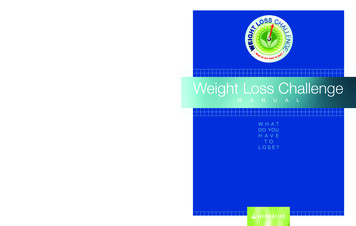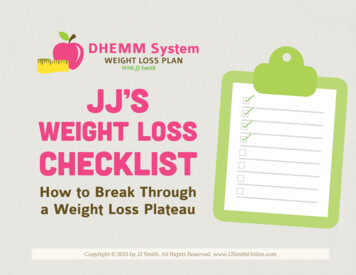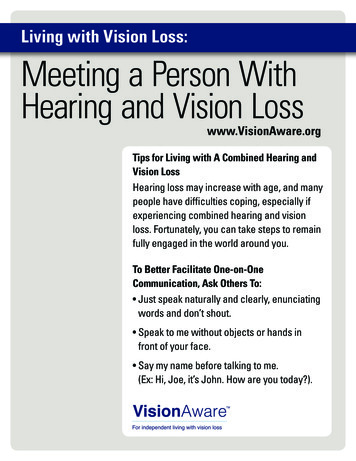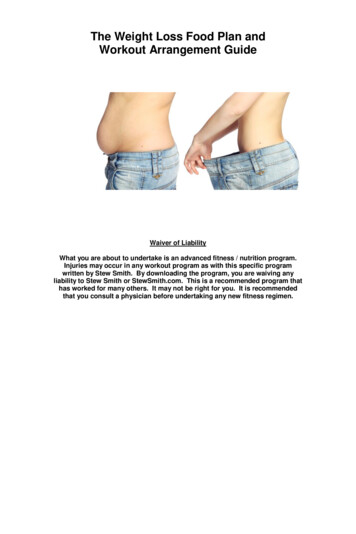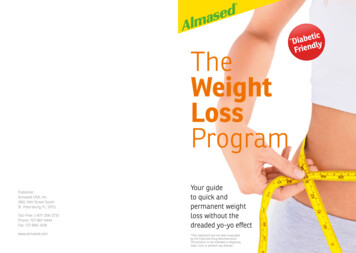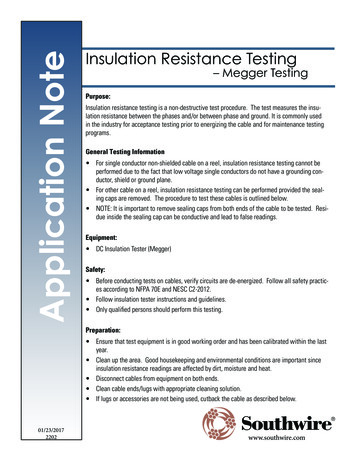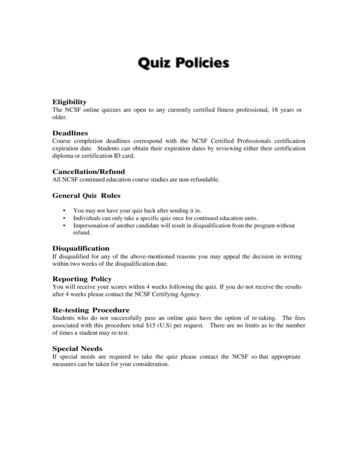
Transcription
EligibilityThe NCSF online quizzes are open to any currently certified fitness professional, 18 years orolder.DeadlinesCourse completion deadlines correspond with the NCSF Certified Professionals certificationexpiration date. Students can obtain their expiration dates by reviewing either their certificationdiploma or certification ID card.Cancellation/RefundAll NCSF continued education course studies are non-refundable.General Quiz Rules You may not have your quiz back after sending it in.Individuals can only take a specific quiz once for continued education units.Impersonation of another candidate will result in disqualification from the program withoutrefund.DisqualificationIf disqualified for any of the above-mentioned reasons you may appeal the decision in writingwithin two weeks of the disqualification date.Reporting PolicyYou will receive your scores within 4 weeks following the quiz. If you do not receive the resultsafter 4 weeks please contact the NCSF Certifying Agency.Re-testing ProcedureStudents who do not successfully pass an online quiz have the option of re-taking. The feesassociated with this procedure total 15 (U.S) per request. There are no limits as to the numberof times a student may re-test.Special NeedsIf special needs are required to take the quiz please contact the NCSF so that appropriatemeasures can be taken for your consideration.
What Do I Mail Back to the NCSF?Students are required to submit the quiz answer form.What do I Need to Score on the Quiz?In order to gain the .5 NCSF continued education units students need to score 80% (8 out of 10)or greater on the CEU quiz.Where Do I Mail My Quiz Answer Form?You will mail your completed answer form to:NCSFAttn: Dept. of Continuing Education5915 Ponce de Leon Blvd., Suite 60Coral Gables, FL 33146How Many CEUs Will I Gain?Professionals who successfully complete the any continuing education quiz will gain .5 NCSFCEUs per quiz.How Much does each quiz cost?Each quiz costs the student 15.00.What Will I Receive When The Course Is Completed?Students who successfully pass any of the NCSF online quizzes will receive their exam scores,and a confirmation letter.How Many Times Can I Take The Quizzes For CEUs?Individuals can take each NCSF quiz once for continuing education credits.
NATIONAL COUNCIL ON STRENGTH & FITNESSWeight Loss and Resistance TrainingWeight loss is a factor of caloric balance, ormore easily stated, energy-in, versus energyout. The seemingly simplistic equationsuggests that if a person consumes less energythan they expend per day they will loseweight. This in fact is true, but the weight thatis lost does not always offer the benefit that isexpected. The ideal weight loss scenario is thereduction of fat mass with the maintenance oflean mass. When caloric restriction plays theprimary role in creating the negative energybalance it is often to the detriment of leanmass. It has been well documented that theutilization of dietary restriction particularlyvery-low-calorie diets (VLCD) for weight lossresults in loss of lean body weight and adecrease in resting metabolic rate. In many casesthe acute and often dramatic adjustment tocaloric intake cause chemoreceptor stimulatedendocrine changes that lead to the loss of theprotein sparing mechanism and metabolic shiftsthat catabolize protein rather than stimulatelipolytic activity. This is particularly true withpartial fasts and meal skipping attempts atweight loss. Dietary adjustments used as the solestrategy for weight loss have a very poor longterm success rate. Successful weight lossincludes several factors, in particular theinclusion of exercise in addition to caloriccontrol.trails analyzing weight loss with themaintenance of fat-free mass consistently showthe importance of adding resistance training todietary modification and aerobic training.Although resistance training does notindependently cause weight loss it does elevateresting metabolic rate and promote fat free mass.Additionally, intense resistance exerciseincreases post-exercise oxygen consumption andshifts substrate oxidation toward a greaterreliance on fat oxidation.Resistance training contributes to successfulweight loss but should not be considered theonly intervention. When 26 weeks of resistancetraining was analyzed for effectiveness onresting energy expenditure (REE), total freeliving energy expenditure (TEE), and activityrelated energy expenditure (AEE), in olderadults, strength (36%) and fat-free mass (2 kg)significantly increased, but body weight did notchange. Resting energy expenditure increased6.8%, whereas resting respiration quotientdecreased from 0.86 to 0.83 identifying greaterreliance on lipid metabolism. Total energyexpenditure increased significantly (12%), andactivity related energy expenditure increased(30%), but again body composition wasmodified, not body weight. When overweightsedentary women (N 44) completed a 20 weekrandomized intervention that included variousdiet and diet plus exercise programs they lostbetween 3.7-5.4 kg. The group that includedresistance training in addition to the diet andReducing caloric intake and adding aerobictraining is possibly the most popularexercise/dietary strategy used for weight loss.The combination of continuous movementincreases caloric expenditure and when added todietary restraint often leads to a negative caloricbalance. This sounds like the ideal scenario, butclinical trials suggest differently. Aerobictraining in conjunction with reduced calorie dietcertainly lead to weight loss, but similarly to astand alone diet strategy, body composition isnot always positively affected. Aerobic trainingdoes not independently, or when acting jointlywith diet promote the maintenance of lean mass.In fact, consistent evidence suggests thatrestrictive diets and endurance training maycause notable losses in lean tissue. Research1
NATIONAL COUNCIL ON STRENGTH & FITNESSthe lean mass yields an added effect, particularlywhen the intensities are elevated. Aerobicexercise performed at intensities greater than70% VO2max increases resting energyexpenditure separate from any change in musclemass. Adding lean mass increases the totalenergy expenditure during the activity. Highintensity exercise training has the added benefitof improving fitness, thus making low-intensityexercise less stressful and more easily tolerated.Many individuals have difficulty withcontinuous, intense steady-state aerobic exercisefor extended periods of time, butintense interval exercise can betolerated and certainly boosts caloricexpenditure.aerobic training was the only group tosignificantly lower body fat percentage. Thesefindings are consistent with other studies thatdemonstrate the significant effect resistancetraining has on the maintenance of lean massabove aerobic training alone.Due to the fact that resistance training maintainslean mass and positively affects metabolism, itdoes not yield significant contributions to fatloss when performed independently. Eventhough aerobic training positively affects fat losswhen combined with dietaryadjustments it should be clear thatthe combination of all threeactivities is valuable in a successfulweight loss program. Additionally,further benefits can be attained byelevating the exercise intensity ofboth the aerobic and anaerobicexercise activities. Elevations inexercise intensity can favorablyimpact energy expenditure. Higherintensity resistance training is morepositively associated with increasesin muscle mass above lowerintensity participation. Added muscle massincreases resting energy expenditure by about10-15 kcal per day per pound, which may notsound like a significant increase, but certainlycontributes to a negative balance. Adding onepound of muscle can equate to over a pound offat energy lost per year in a resting state. Whencombined with aerobic training the addition ofWarm-up5 exercise lower body resistance circuit10 minute interval biking5 exercise upper body resistance circuit10 minutes interval stepping4 exercise core circuit10 minute interval bikingCool down and stretchThe combination of strength exercisewith interval training is a veryeffective means for exercise aimed atweight loss and can easily beprogrammed into personal trainingexercise sessions. Focusing on caloricexpenditure allows for numerousexercise scenarios. Working within thecapabilities of the client andconsidering his or her relative exercise toleranceare two key considerations for successfulprogramming when attempting to raise exerciseintensities in a workout. In most cases shorterintermittent activities are better tolerated bothpsychologically and physiologically for manyclients. Consider the following two scenarios.Warm-up3 exercise lower body resistance superset2 minutes jump rope3 exercise upper body resistance superset3 minutes biking2 exercise core resistance superset10 minute interval stepping6 exercise total body circuitCool down and stretchshould emphasize continuous activity. Acommon error in personal training isexcessive rest within an exercise bout. Therest interval is the limiting factor inresistance training for weight loss. TheProgramming for weight loss shouldemphasize chronic behavior change ratherthan acute behavior adjustments. Thissuggests applying a gradual acclimation thatre-enforces permanent changes. The goal2
NATIONAL COUNCIL ON STRENGTH & FITNESSless successful outcomes. Consistent,prudent modifications to diet and exercisewill lead to weight loss and improvements inbody composition.application of progressive overload shouldbe systematically programmed pushing forgreater volume and reduced rest intervals.Avoid dramatic adjustments and overlyaggressive progressions as they often lead toBrief Research Review Hunter GR,Weinsier RL,Bamman MM,Larson DE.Int J Obes Relat Metab Disord. 1998 Jun;22(6):489-93Suggest that although resistance training may elevate resting metabolic rate, it does notsubstantially enhance daily energy expenditure in free-living individuals. Several studiesindicate that intense resistance exercise increases postexercise oxygen consumption andshifts substrate oxidation toward a greater reliance on fat oxidation. Preliminary evidencesuggests that although resistance training increases muscular strength and endurance, itseffects on energy balance and regulation of body weight appear to be primarily mediatedby its effects on body composition (e.g., increasing fat-free mass) rather than by thedirect energy costs of the resistance exercise. Poehlman ET, Melby CInt J Sport Nutr. 1998 Jun;8(2):143-59The purpose of this study was to determine what effects 26 wk of resistance training haveon resting energy expenditure (REE), total free-living energy expenditure (TEE), activityrelated energy expenditure (AEE), engagement in free-living physical activity asmeasured by the activity-related time equivalent (ARTE) index, and respiratory exchangeratio (RER) in 61- to 77-yr-old men (n 8) and women (n 7). Before and after training,body composition (four-compartment model), strength, REE, TEE (doubly labeledwater), AEE (TEE - REE thermic response to meals), and ARTE (AEE adjusted forenergy cost of standard activities) were evaluated. Strength (36%) and fat-free mass (2kg) significantly increased, but body weight did not change. REE increased 6.8%,whereas resting RER decreased from 0.86 to 0.83. TEE (12%) and ARTE (38%)increased significantly, and AEE (30%) approached significance (P 0.06). The TEEincrease remained significant even after adjustment for the energy expenditure of theresistance training. In response to resistance training, TEE increased and RER decreased.The increase in TEE occurred as a result of increases in both REE and physical activity.These results suggest that resistance training may have value in increasing energyexpenditure and lipid oxidation rates in older adults, thereby improving their metabolicprofiles.3
NATIONAL COUNCIL ON STRENGTH & FITNESS Hunter GR,Wetzstein CJ,Fields DA,Brown A,Bamman MM.J Appl Physiol. 2000 Sep;89(3):977-84.OBJECTIVE: Utilization of very-low-calorie diets (VLCD) for weight loss results in lossof lean body weight (LBW) and a decrease in resting metabolic rate (RMR). The additionof aerobic exercise does not prevent this. The purpose of this study was to examine theeffect of intensive, high volume resistance training combined with a VLCD on theseparameters. METHODS: Twenty subjects (17 women, three men), mean age 38 years,were randomly assigned to either standard treatment control plus diet (C D), n 10, orresistance exercise plus diet (R D), n 10. Both groups consumed 800 kcal/day liquidformula diets for 12 weeks. The C D group exercised 1 hour four times/week bywalking, biking or stair climbing. The R D group performed resistance training 3days/week at 10 stations increasing from two sets of 8 to 15 repetitions to four sets of 8 to15 repetitions by 12 weeks. Groups were similar at baseline with respect to weight, bodycomposition, aerobic capacity, and resting metabolic rate. RESULTS: Maximum oxygenconsumption (Max VO2) increased significantly (p 0.05) but equally in both groups.Body weight decreased significantly more (p 0.01) in C D than R D. The C D grouplost a significant (p 0.05) amount of LBW (51 to 47 kg). No decrease in LBW wasobserved in R D. In addition, R D had an increase (p 0.05) in RMR O2 ml/kg/min (2.6to 3.1). The 24 hour RMR decreased (p 0.05) in the C D group. CONCLUSION: Theaddition of an intensive, high volume resistance training program resulted in preservationof LBW and RMR during weight loss with a VLCD. Bryner RW,Ullrich IH,Sauers J,Donley D,Hornsby G,Kolar M,Yeater R.J Am Coll Nutr. 1999 Apr;18(2):115-21Effects of large (LA; 400 min/wk) and moderate (MA; 200 min/wk) amounts ofendurance exercise in combination with weight training (3 d/wk) were compared with theeffects of no exercise (C) in 23 obese females after a 12-wk, 3360-kJ/d very-low-energydiet (VLED). The LA group lost 6.5 kg more weight, mainly as fat (6.4 kg), than the Cgroup (P 0.05). No measurable differences were found among groups for decreases inresting metabolic rate (-729 to -1233 kJ/d; NS) or fat-free mass (-2.9 to -3.9 kg; NS). Noimprovements in aerobic capacity were achieved with the addition of exercise to a VLED(-0.079 to -0.037 L/min; NS). Strength indexes were improved ( 16 to 5 kg; P 0.05)or maintained with exercise (-3 kg; NS) whereas a loss (-9.3 kg; P 0.05) or maintenance4
NATIONAL COUNCIL ON STRENGTH & FITNESS( 4.5 kg; NS) was found for VLED alone. Large amounts of endurance exercise incombination with weight training added to a VLED appear to improve weight and fat losscompared with a VLED alone. Whatley JE,Gillespie WJ,Honig J,Walsh MJ,Blackburn AL,Blackburn GLAm J Clin Nutr. 1994 May;59(5):1088-92Weight-loss programs usually result in fat-free mass (FFM) loss along with body-fat (BF) loss.This study examined which combination of diet exercise would maintain FFM. Forty-fouroverweight, inactive women completed 20 wk of a randomized intervention: control (C, N 6),diet only (D, N 10), diet cycling (DC, N 8), diet resistance training (DR, N 11), or diet resistance training cycling (DRC, N 9) group. FFM and %BF were determined fromhydrostatic weighting. Exercise sessions were attended 3 d.wk-1, with a mean duration of 30 minper session. Caloric intake was reduced 628 kcal.d-1 ( /- 59). Chi squares and ANOVA showedno baseline differences between groups for socioeconomic status, age, body composition, aerobiccapacity, or strength. One-way ANOVA of change with Student-Newman Keul multiple rangepost-hoc tests (P 0.05) were used to analyze pre to post differences for %BF, body mass (BM),FFM, VO2max, and strength. D, DC, DR, and DRC lost significant BM (-3.7 to -5.4 kg) incomparison with C ( 1.5 kg). All groups maintained FFM but only DRC significantly lowered%BF (-4.7%) in comparison with C. DRC and DC significantly increased VO2max. Strength1RM (triceps extension, arm curl, leg extension, chest press) increased significantly for both DRand DRC. Results suggest that moderate levels of caloric restriction, aerobic cycle exercise,and/or resistance training are equally effective in maintaining FFM while encouraging body massloss.5
NATIONAL COUNCIL ON STRENGTH & FITNESSQUIZ1) Reducing your caloric intake and adding resistance training to your weight lossprogram is the most efficient way of reducing body weight.a) Trueb) False2) What is the possible disadvantage of a weight loss program that focus solely oncaloric restriction?a)b)c)d)decline in lean body massdecline in resting metabolismloss of protein sparring mechanismall of the above3) What is a benefit of adding aerobic exercise to a weight loss program?a)b)c)d)Increased muscle massIncreased caloric expenditureMaintenance of lean muscle massAll of the above4) Performing aerobic and anaerobic activities at high intensities without any restrictionin caloric intake will result in optimal body composition adjustments?a) Trueb) False5) Why is it important to include resistance training in a weight loss program?a)b)c)d)e)To increase muscle and bone strengthTo increase resting energy expenditureTo increase resting respiration quotientA and B are correctAll of the above6) With each pound of muscle that a person gains, their energy expenditure increases byabout ?a)b)c)d)35-30 Kcal per day15-20 Kcal per day22-30 Kcal per day10-15 Kcal per day6
NATIONAL COUNCIL ON STRENGTH & FITNESS7) Which of the following are important considerations when raising the exerciseintensities in a workout?a) Working within the client’s capabilitiesb) Are their health considerationsc) Considering the persons relative exercise toleranced) All of the above8) True or False? Programming for weight loss should emphasize aggressive, but acutebehavior adjustment?a) Trueb) False9) A common error in personal training is:a)b)c)d)Inadequate intensities to stimulate adaptationBeginning a client with too high of an intensityExcessive rest in between setsAll of the above10) Due to the difficulty that some individuals have with continuous, intense steady-stateaerobic exercise, a trainer may acclimate a client in a program by using ?a)b)c)d)High intensity resistance trainingShort sprint trainingClient appropriate interval trainingall of the above7
FIRST NAMELAST POSTAL CODECERTIFICATION NO.CERTIFICATION EXP.MEMBERSHIP NO.MEMBERSHIP EXP.////MemberPriceQuiz NameTotal 15DiscoverVisaMastercardAccount No.AmexExp. DateSignatureCheck/Money OrderSecurity CodeDateQuiz AnswersFill in each blank with the correct choice onthe answer sheet. To receive 0.5 CEUs, youmust answer 8 of the 10 questions correctly.1.6.2.7.3.8.4.9.NCSF5915 Ponce de Leon Blvd., Suite 60Coral Gables, FL 331465.10.Questions? 800-772-NCSFPlease mail this Quiz answer form alongwith the proper enclosed payment to:
trails analyzing weight loss with the maintenance of fat-free mass consistently show the importance of adding resistance training to dietary modification and aerobic training. Although resistance training does not independently cause weight loss it does elevate resting m

